Final report for GW19-191
Project Information
Little is understood about the interactions between and Fusarium wilt. What is the physiological basis for the deficit irrigation (DI)– plant interaction? How does the relationship between DI and disease change under variable plant and soil nutrient conditions? Can altering land management affect this relationship? In this project we will use two controlled greenhouse trials to study these interactions then collaborate with the Russell Ranch Agricultural Sustainability Institute to conduct field trials studying the effects of DI on disease development in conventional and organic systems. We aim to create disease management recommendations for growers that account for water use and nutrient management, enabling the continued use of DI. This project takes a novel systems-based approach to improve ecological and economic sustainability of tomato agroecosystems by simultaneously improving water efficiency, increasing yield, decreasing fungicide use, and improving nutrient management.
Outcome 1: Improve the profitability of farmers by reducing losses due to Fusarium wilt
- Reduction in detection of Fusarium wilt in tomato fields, based on number of samples submitted to the Swett Diagnostic lab in 2021 compared to the average in 2018 – 2020.
- Increase in the annual production yields reported by the California Tomato Growers Association.
2: Improve the environmental quality and natural resource base by reducing water and chemical use.
- 20-50% of CTRI members reporting that water use management strategies were considered as part of an integrated disease management plan.
- 30% of the growers using DI report awareness and preparedness in regard to disease risks
- DPR reports indicate a reduction in fungicide applications/acre.
3:Tailor nutrient applications by providing workshops and materials regarding the interactions between DI, disease, and nutrient applications.
- 20-50% of CTRI growers reporting that nutrient management strategies were considered as part of a Fusarium wilt management plan.
- 5-10% of growers using DI reporting a change in their nutrient practices rates to mitigate risks.
Our primary goal is to take a systems-based approach to develop disease-water-nutrient co-management recommendations for tomato growers. The aim is to develop deficit irrigation methods that increase water use efficiency while improving plant nutrition and disease management. We aim to better understand and manage the interactions between deficit irrigation, Fusarium wilt, and soil health management on plant hormone production, growth and yield, and disease development by:
- Determining the physiological basis for deficit irrigation – plant interactions
We will test the hypothesis that deficit irrigation alters disease dynamics through drought stress predisposition, characterized on the basis of plant hormone induction.
- Examining the relationship between deficit irrigation, nutrients, and Fusarium wilt development
- We will test the hypothesis that reductions in nutrient availability alter deficit irrigation-pathogen interactions; results will be used advise Objective 2b. This study will provide critical information on how plant nutrient affectsdeficit irrigation -plant pathogen interactions.
- We will test the hypothesis that targeted potassium and nitrogen amendments can be used to reduce water stress and disease predisposition associated with deficit irrigation.
- Examining the effect of land use management on plant nutrition and disease development under deficit irrigation
- We will develop baseline information on impacts of deficit irrigation on Fusarium wilt development in a field setting.
- We will test the hypothesis that land use management strategies which enhance plant nutrients can be used to reduce water stress and disease predisposition under deficit irrigation. The results of this study will inform the development of management recommendations.
Cooperators
- - Technical Advisor
- - Technical Advisor
- - Technical Advisor
- - Technical Advisor (Researcher)
- - Technical Advisor
- - Technical Advisor (Educator and Researcher)
- - Technical Advisor (Researcher)
Research
Objective 1: Determining the physiological basis for deficit irrigation - plant interactions
Fusarium oxysporum f. sp. lycopersici (Fol) race 3 susceptible processing tomato cultivar H8504 seeds were surface disinfested then planted in 72-plug trays using UC Mix substrate. Seedlings were transplanted to 2-gallon pots filled with UC Mix after approximately one week under mist and bottom heat. Osmocote was buried approximately 10 cm deep near the center of the pots. After two additional weeks, the pots were placed onto greenhouse benches and set at their prospective irrigation points. The experiment began on July 17 (once the pots reached their prospective soil moisture levels, or volumetric water contents (VWC)) and continued for up to 12 weeks, depending on the treatment.
Irrigation Treatments:
These experiments utilized a Decagon irrigation system where specific volumetric water contents (VWCs) were set and sensors measured soil moisture levels and alerted the system when they had decreased below the established VWC. At this point the system turned on the irrigation for a set period of time. Using Mayim Sensorweb, VWC was remotely monitored. Tomatoes were irrigated at one of two irrigation set points: “Saturated” (45% VWC) or “Deficit" (28% VWC). Sensors were placed randomly in three pots within each of the eight plots. The average VWC measurement from the three sensors in each block was utilized to determine when a block should be irrigated. There were four blocks of the two irrigation treatments for a total of eight plots.
In addition to soil moisture treatments, deficit irrigation duration was also a variable. Half of the plants under the "deficit" treatment was exposed for two weeks, while the other half was exposed for four weeks.
Pathogen Treatments:
The tomato root rot pathogen Phytophthora capsici was used in addition to the tomato wilt pathogen Fusarium oxysporum f. sp. lycopersici (Fol) for a total of three pathogen treatments: P. capsici, Fol, and non-inoculated.
Plant Hormone Measurements:
Starting at day 0, leaves from a subset of tomato plants from each replicated treatment were removed for abscisic acid (ABA), salicylic acid (SA) and jasmonic acid (JA) measurements. One leaf was removed from each of the three plants within each treatment in each block to form composite samples. This was done nine times over the course of the experiment.
Plant measurements:
Eight weeks into the experiment, plants were evaluated for aboveground symptoms on a weekly basis. At the conclusion of the experiment, fresh and dry shoot weights were measured for each plant. For plants inoculated with Fol, vascular discoloration was recorded. For plants inoculated with P. capsici crown rot, root presence (%) and root necrosis (%) were also recorded.
Objective 2: Studying the effects of deficit irrigation in a controlled field study
Originally, this objective's aim was to examine the effects of nutrients and deficit irrigation on disease development. However, after completing the first year of Objective 1, we realized that it was important to study the effects of deficit irrigation on disease development in a more controlled field setting that included plant stress metrics.
In this objective, we set up a field trial at the Armstrong Plant Pathology Field Research Station in Davis, CA. In a split split plot design, tomato cultivar (two with different tolerance to Fusarium falciforme as shown in previous work) was the main plot and irrigation (four levels encompassing well-watered and deficit treatments based on evapotranspiration (ET) and volumetric water content (VWC)) was the subplot. The 8 cultivar-irrigation treatments were replicated twice in each of the three blocks for a total of 48 replicated treatments.
Pathogen inoculation
Tomato seedlings were dip inoculated into a slurry of 1 x 10E5 spore suspension of F. falciforme in 0.1% water agar for 60 seconds before transplantation. Non-inoculated seedlings were transplanted to a separate clean field with the same four irrigation treatments.
Irrigation monitoring
All treatments received enough water to satisfy approximately 100% of evapotranspiration (ET) requirements for the first ten weeks post transplant. At ten weeks, the deficit treatments began. ET and volumetric water content (VWC) levels were monitored using a Tule system and GS-1 soil moisture sensors. For the ET treatments, the well-watered plots received irrigation to satisfy 100% of ET needs whereas the deficit plots received irrigation to satisfy 60%. For the VWC treatments, the well-watered plots were irrigated to maintain VWC at 35% while the deficit plots were irrigated to maintain VWC at 28%. These levels were pre-determined using a soil moisture release curve created using a HYPROP.
Plant Stress Monitoring
Stem water potential was measured just before the start of the deficit treatments and then twice more. Due to poor air quality, further measurements could not be completed. Between 12:00PM and 4:00PM, packets were placed around three leaflets on three plants in each treatment for 15 minutes before a pressure bomb was used to measure stem water potential. Measurements were taken on the same plants each time. In addition, Dr. Mallika Nocco, a faculty member of the Department of Land, Air, and Water Resources at UC Davis, took aerial images of the field to capture temperature differences and thus water stress.
Disease Monitoring
Disease monitoring throughout the growing season was conducted in the inoculated field, however the clean field was examined for below ground symptoms only at harvest. In the inoculated field, aboveground disease (decline symptoms) was monitored in plots containing 15 plants in each of the 48 plots at 0, 2, 8, and 10 weeks after the start of the deficit irrigation treatments. Belowground disease (foot rot, crown rot, and stem rot) was monitored by randomly selecting and excavating three plants from each of the 48 plots (outside of the aboveground monitoring plots) at 0, 4, and 9 weeks after the start of the deficit irrigation treatments.
Harvest Data
Approximately 19 weeks post-transplant plants were excavated from 15' plots within all plots in the inoculated and clean fields. All fruit was removed from the plants and combined by plot before sorting into three categories and weighing: Red marketable, green, and rotten. Red marketable fruit was selected from each plot for quality analysis (Brix, hue, and pH) by the Processing Tomato Advisory Board.
Objective 3: Examining the effect of land use management on plant nutrition and disease development under deficit irrigation
For this objective we monitored Fusarium disease development in a processing tomato cultivar grown under different irrigation and soil amendment treatments over two years. The irrigation treatments were "Well-Watered" (irrigation meeting 100% of evapotranspiration (ET) needs) or "Deficit" (irrigation meeting 60% of ET needs) as measured by a Tule system. The soil amendment treatments were "Synthetic" (180 lb N/acre) or "Compost" (180 lb N/acre with 2 tons/acre composted poultry manure). Each irrigation-soil amendment treatment was replicated three times. Leaf nutrient data was taken at the end of each growing season. Soil nutrients were measured before planting and again at harvest.
Objective 1: Determining the physiological basis for deficit irrigation - plant interactions
Hormone Results
ABA production, which is a way to measure drought stress in plants, increased in plants under deficit irrigation but only those that were under the treatment for four (as opposed to two) weeks (Fig. 1). Interestingly, ABA production continued to increase in plants even after they were returned to well-watered conditions. SA production, which can be triggered upon pathogen infection, did not significantly increase in any of our treatments, although many plants demonstrated severe disease symptoms. An increase in JA production, which can also be triggered upon pathogen infection, increased once inoculated plants under deficit irrigation for four weeks (but not two weeks) were returned to well-watered conditions. These results suggest that longer periods of deficit irrigation may be required to detect changes in hormone production in future work. It is understood that ABA production can inhibit the production of JA and SA thus it is unclear why there was an increase of both ABA and JA after plants were returned to well-watered conditions.
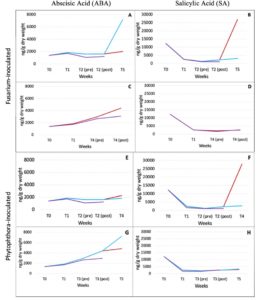
Disease Measurements
In general, disease measurements (disease ratings, shoot fresh weights, root necrosis, and vascular discoloration) were least prevalent in the well-watered non-inoculated plants and most prevalent in deficit irrigated inoculated plants (Figs 2-4). In many cases, inoculated plants that were exposed to deficit irrigation for four weeks rather than two weeks exhibited greater disease symptoms.
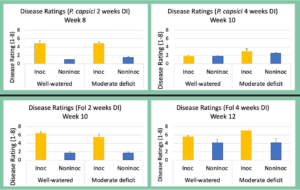
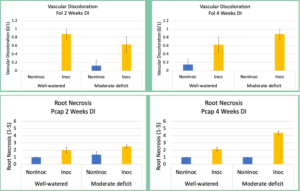
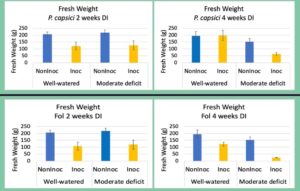
Objective 2: Studying the effects of deficit irrigation in a controlled field study
Measuring Plant Water Stress
At the onset of the DI treatment, stem water potential was relatively similar across all irrigation treatments in both cultivars, with the exception of the OPT-ET treatment (Fig. 5). Two weeks post-DI onset lower (more negative) stem water potential results were observed in the HM58841 cultivar, perhaps indicating that these plants were under more water stress. Lower stem water potential measurements were generally observed in the deficit treatments, confirming an irrigation treatment effect.
We have begun to collaborate with Dr. Mallika Nocco from the UC Davis Department of Land, Air, and Water. Drone images (Normalized Difference Vegetative Index (NDVI) and heat map) were taken two weeks post-DI onset (Fig. 6). While the resolution of these images does not afford us the ability to observe treatment differences, future work will include drone images captured over three different dates with greater resolution.
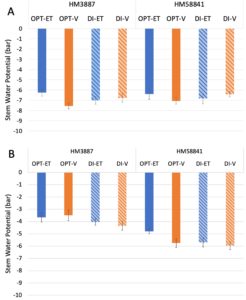
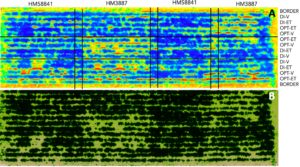
Disease Measurements
We observed more whole plant decline and foot rot under the deficit treatments, regardless of scheduling method in the HM3887 cultivar, however the opposite was true in HM58841 (Figs 7 and 8). Differences do not appear to be significant.
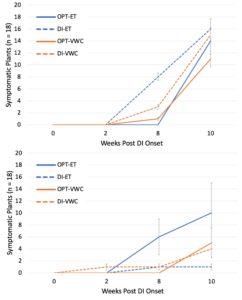
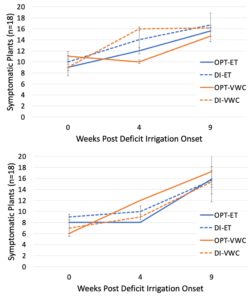
Fruit Yield and Quality
Overall HM3887 plants produced higher yields than HM58841 plants, however Brix and hue were lower and pH was higher in HM3887 (Figs. 9 and 10). Under the DI-ET treatment HM3887 plants produced higher yields and lower yields under the OPT-ET treatment. HM58841 plants produced higher yields under the OPT-V treatment and lower yields under the OPT-ET treatment. A large portion of harvested fruit was still green, perhaps due to heavy wildfire smoke in the last weeks of the growing season.
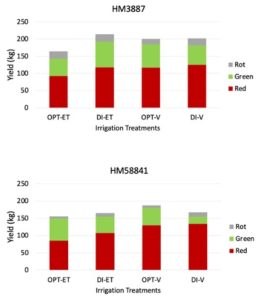
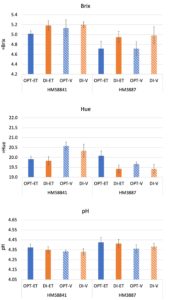
Objective 3: Examining the effect of land use management on plant nutrition and disease development under deficit irrigation
Soil and Leaf Nutrients
2019 and 2020 pre-planting soil fertility measurements did not reveal significant or consistent differences in nitrogen, phosphorus, or potassium however rates of increase were highest for nitrogen levels in the well-watered synthetic treatment (Fig. 11).
In the first year, greater leaf nitrogen levels were found in plants grown in the synthetic treatment, however differences were not significant (Fig. 12). Although no trends were observed in phosphorus or potassium levels between irrigation and soil amendment treatments, leaves in the deficit-compost treatment had significantly less potassium than the other treatments.
In the second year we observed more leaf nitrogen under compost, regardless of irrigation treatment 7 weeks pre-DI onset (Fig. 13). This relationship disappeared over the next eight weeks: 1 week post-DI onset leaf nitrogen was significantly higher in the well-watered treatment under both soil amendments. Although there were no significant differences between leaf phosphorus content before DI onset, we observed more under deficit one week after the treatment began for both soil amendments. The relationship between leaf sulfur content shifted the most, with plants in the well-watered treatment having greater sulfur 7 weeks pre-DI onset but significantly less than the DI plants by 1 week post-DI onset. The opposite seemed true of the leaf potassium content, with differences between soil amendment treatments (greater leaf K under compost than the synthetic fertilizer) disappearing after DI onset.
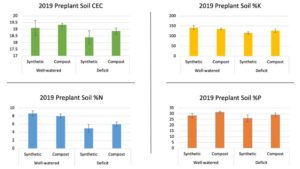
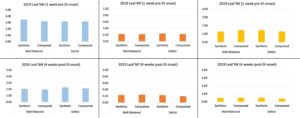
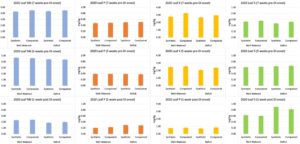
Disease Measurements
We observed greater whole plant decline in 2019 than in 2020 (Fig. 14) with more symptoms under DI in both years. The difference in symptoms between the deficit and well-watered treatments increased in the second year. Compost did not appear to protect plants under DI in either year.
We observed more foot rot symptoms in the second year of the study; noteworthy is the high incidence of foot rot in all treatments at the DI treatment onset (Fig. 15). At harvest, more foot rot was observed under DI and the synthetic fertilizer amendment; plants in the DI treatment with compost had less foot rot than in the well-watered compost treatment. Overall, the least foot rot symptoms were observed in the well-watered synthetic fertilizer treatment.
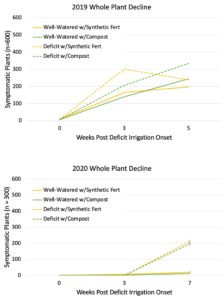
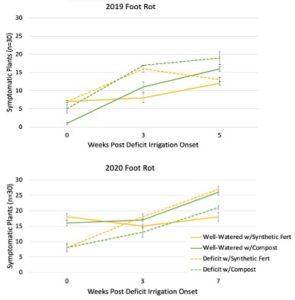
Fruit Yield and Quality
2019 tomato yields were significantly higher under well-watered conditions than under deficit in both soil amendments and there was no effect of soil amendment (Fig. 16). Similar results were observed in 2020, however it is important to point out that the 2019 data are calculated from a greater area of the field and are thus most likely more representative of actual yields than the 2020 data, which are calculated from smaller plots (Fig. 17). In 2019, fruit had slightly higher hue and pH values under deficit irrigation (Fig. 18). In 2020, fruit had significantly higher Brix under DI, but only in the compost treatment (Fig. 19). Fruit hue was higher in the well-watered treatment for both amendments, but these were not significantly higher than the DI-compost fruits. Lastly, fruit pH was highest in the DI treatment, particularly under the synthetic fertilizer.
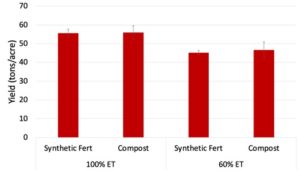
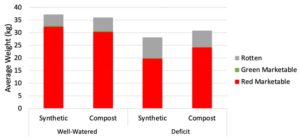
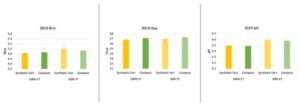
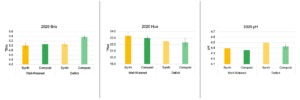
Research Outcomes
Education and Outreach
Participation Summary:
Every year the Russell Ranch Sustainable Agriculture Facility hosts a field day in which growers and extension educators can tour the facility.
In August 2019 the Swett Lab hosted a field day where we hosted approximately 25 growers. Although my field trial at Armstrong did not start until 2020, I was able to talk to them about my Russell Ranch study.
Due to the global pandemic we have not yet been able to accomplish our education and outreach goals. However we plan to publish our findings in at least two peer-reviewed journal articles. I also hope to present this research at grower meetings in Fall and Winter 2021 and at conferences over the next year where we will create slideshows, posters, and handouts to communicate our findings. We plan to update the UC Davis IPM website making our findings available to the public. In addition, we hope to create a fact sheet describing the effects of deficit irrigation on tomato health, with an emphasis on Fusarium diseases. Proper citation of Western SARE as the funding organization in all materials produced from this proposal will be utilized.
We will distribute the Western SARE evaluation form along with a survey we developed specifically for this proposal at grower meetings where this research is presented.